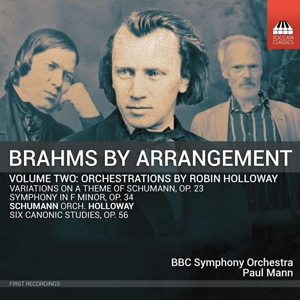
Brahms by Arrangement Volume Two: Orchestrations by Robin Holloway
Johannes Brahms (1833-1897)
Variations on a theme of Schumann Op. 23 (1861, orch. Robin Holloway2016)
Robert Schumann (1810-1856)
Six Canonic Studies (1845, arr. Claude Debussy1891, orch. Robin Holloway 2011)
Johannes Brahms
Symphony in F minor after the Sonata for Two Pianos Op. 34a (1864, orch. Robin Holloway 2008)
BBC Symphony Orchestra/Paul Mann
rec. 2022, Studio MV1, BBC Maida Vale Studios, London, UK
Toccata Classics TOCC0450 [85]
Brahms’ Piano Quintet had a difficult start. The composer first drafted it in 1862 as a string quintet with two cellos, the same combination that Schubert used, but Clara Schumann and Brahms’s friend the violinist Joseph Joachim expressed doubts about this version. Brahms recast it as the Sonata for Two Pianos Op. 34A, which he published. He destroyed the original string quintet version, but it has been reconstructed not once but twice, first by Sebastian Brown (review) and, more recently, by Anssi Kartunen, recorded in the first of these Brahms by arrangement discs from Toccata (review). This time Clara, again, and the conductor Hermann Levi were not happy with it. Brahms recast it as the Piano Quintet Op. 34, in which form it has become established as the splendid work it undoubtedly is. However, Clara also said that really it should be orchestrated. Robin Holloway, who has long been fascinated by the work, took up the challenge and in 2008 made the orchestration we have here; this is its first recording. He has also boldly retitled it as Symphony in F minor. This was a sensible move: Schoenberg’s orchestration of the slightly earlier G minor Piano Quartet Op. 25 would have had an easier passage had Schoenberg similarly retitled it Symphony in G minor.
In his very informative sleeve note, Holloway explains that the Piano Quintet version aims to have the piano for weight, the strings for cantabile and sostenuto but that this makes ‘a factitious concerto-like struggle’ and creates ‘a sense of thwartment within the music itself’ (I hadn’t come across ‘thwartment’ before). He thinks the two piano version is the better one and that some of the writing in the piano quintet version is not successful. He based his transcription on the two-piano version and has followed Schoenberg in aiming to be ‘faithful in spirit not letter’. He does not restrict himself to the instruments and techniques of Brahms’s time – nor did Schoenberg – and Holloway calls his orchestration of the G minor Piano Quartet ‘marvellous’.
This is the main work here and I want to say straightaway that, like the Schoenberg orchestration, it sounds marvellous. Yes of course it still sounds like Brahms, but a rather more colourful Brahms than we are used to in his own orchestral works. All the power and passion of the work come across. Of course, this does not detract from either the two piano or the piano quintet version but simply gives us another way of enjoying this splendid work. I note that some recent recordings of Brahms’s symphonies, such as those by Michael Gielen, add the Schoenberg version of the G minor piano quartet as a quasi-additional symphony. I would be very happy if this version of the piano quintet achieved equal acceptance.
It is preceded by two smaller works. Brahms composed his Variations on a Theme of Schumann Op. 23 for piano duet in 1861, five years after Robert’s death and dedicated to the Schumanns’ daughter Julie. The theme was the one called Schumann’s ‘last musical idea,’ which he believed was dictated to him by the spirits of Schubert and Mendelssohn when he was already in the grip of the mental illness which led to his confinement and death. Writing variations on it was a homage to the earlier composer. The theme is followed by ten variations and an epilogue, mostly gentle and rather sad. Holloway’s orchestration makes this a work rather like Brahms’s early orchestral serenades, with a prominent role for solo clarinet.
Then we have a work actually by Schumann, his Six Canonic Studies Op. 56 written for pedal piano. This was a piano fitted with a pedal board like those in organs. It did not last long. Debussy arranged these pieces for two pianos and Holloway used Debussy’s version rather than the original as the basis for his transcription for chamber orchestra. He brings out the canonic writing sometimes by giving the leader to one instrument, say the oboe, and the follower to a different one, say the clarinet. This is a minor work but an attractive one.
Paul Mann, the conductor here, was chief conductor of the Odense Symphony Orchestra in Denmark and has conducted widely in the UK and elsewhere. He is also practically the house conductor for the Toccata label, having made many recordings for them. Here he leads the BBC Symphony Orchestra, whose expertise with unfamiliar scores needs no stressing. The recording is good and the sleeve note, from which I have drawn, helpful. Brahmsians who are not averse to transcriptions should explore this.
Stephen Barber
Help us financially by purchasing from



















